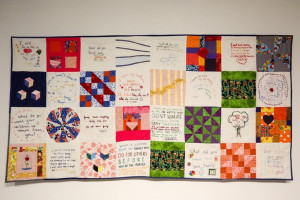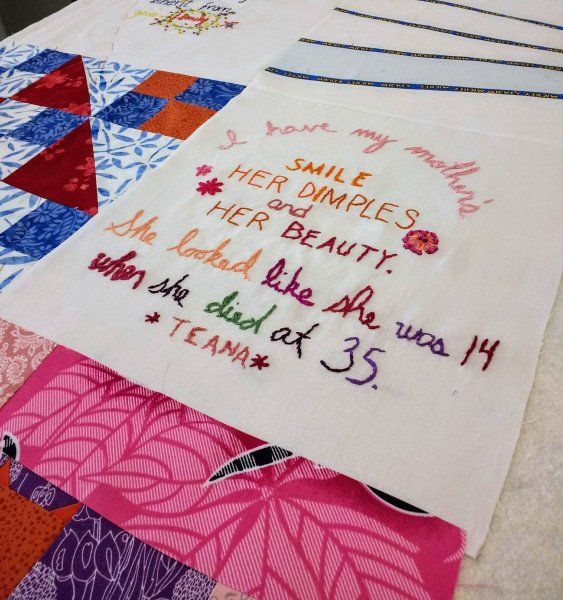
Above: A 24-panel quilt designed by Rachel Wallis MA '16 called Inheritance.
Rachel Wallis MA '16 is the first artist in residence for Project NIA, a grassroots organization that works to end the arrest, detention, and incarceration of children and young adults by promoting restorative and transformative justice practices. Wallis is an activist who uses art in organizing work, and an artist who engages in issues of racial and social justice. As a community taught textile artist, her work spans the divide between fine art and craft. She believes that traditional textile techniques, particularly quilting, can provide a fertile platform for creating dialogue and understanding around complex ideas and issues. She talked with Communications Intern Samantha Weinraub.
Where are you from? Where are you based now?
I grew up in Cleveland and spent my 20s and early 30s in Chicago. The last couple of years we've been moving around, but last year we settled down in Columbus, Ohio, hopefully for good.
How do you feel about getting the residency?
I can't even begin to express what this residency means to me. Mariame Kaba (founder of Project NIA) has had an enormous influence on my politics, and my understanding of the ways that artists can engage with movements for justice. For her to reach out to me for this opportunity is an enormous honor. It also means a lot because I've really been struggling in my personal art practice recently. My work is deeply collaborative, and I've been struggling to envision my next project in a new city, where I'm not connected to local organizations, and during a pandemic where sewing together isn't really possible. This residency gives me a new direction to move in, and the freedom to really invest in a more solo practice while still feeling like a part of a larger movement.
What are you doing for the residency?
Mariame is currently writing a piece on the Anguilla Prison Camp massacre in 1947, when eight Black prison laborers were killed for refusing to work barefoot in snake infested waters. She asked me to design a quilt that would help tell their stories. I'm hoping to make a quilt that would incorporate a map of the highways they were working on (all of the highways in Georgia were laid with prison labor), images of the men, and a snake motif. I'm planning on hand-dyeing all of the fabric, if possible with dyes that could be grown in Georgia.

What do you hope to accomplish during the residency? What legacy would you like to leave?
I always go into my projects with multiple goals. Art is a way for me to learn about history, to engage in deeper research, and reflect on these larger questions about race, power, history, and incarceration. I also hope that my quilts will help tell a story that is not widely known. In this case, about the way that prison labor replaced slave labor in much of the south, with the same kinds of brutality and deadly consequences. I hope they will encourage people to recognize the humanity of the people we lock away in prisons, and challenge them to imagine a future without prisons and police and take steps to building it. I partner with organizations like Project NIA, who are doing the work every day on the ground level, so that my art can hopefully connect people to meaningful ongoing organizing.
How is what you learned at Moore informing your work for this residency?
When I was at Moore I was working on my first quilt collaboration with Mariame Kaba—Gone But Not Forgotten—a community memorial quilt honoring individuals killed by the Chicago police. Throughout my time at Moore I was struggling with the questions that are still central to my practice: How do we make art that addresses the root causes of injustice and moves viewers and participants towards action? How do you work respectfully and responsibly with movements and communities you're not always a part of? What is my role as a white artist creating work about racism and white supremacy? How do you document and exhibit work that is collaborative and evolving, that is as much about process as outcomes? I feel really lucky that I got to take the time to really process these questions, not just in theory but directly as they related to my ongoing work.

How does quilting influence humanity?
Every quilt tells a story. They tell stories of births and deaths and weddings. They tell stories through the materials they're made with—feed sacks and newspapers during the great depression, or crazy quilts with beloved scraps of velvet and silk left over from garments or gifts. Textiles connect us to feelings of love and family, and can be used to expand that empathy in new directions and towards different communities.
